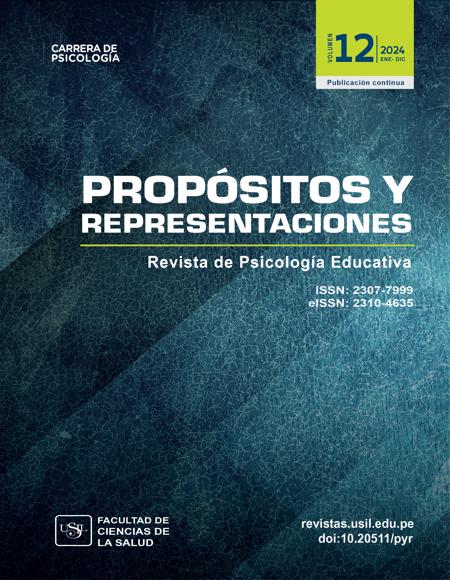Perfil bibliométrico sobre las conductas antisociales y agresión física en adolescentes escolarizados
Bibliometric profile on antisocial behaviors and physical aggression in school-going adolescents
##plugins.themes.bootstrap3.article.main##
Explorar las conductas disruptivas en adolescentes de educación básica y sus implicancias sobre su desarrollo, resulta necesario para disponer de información actualizada y apodar medidas coherentes. Por ello se planteó como objetivo evaluar la literatura científica sobre conductas antisociales y agresión física en adolescentes escolarizados en la base de datos de Scopus entre los años 2010 y 2024. Se empleó como método la Scoping review para estudios bibliométricos, los términos empleados fueron: disruptive behavior, antisocial behaviour, deviant behavior, physical aggression, aggression, corporal aggression, adolescent junto con operadores boleanos AND, OR. Los resultados del estudio incluyeron 989 manuscritos, de los cuales 81.2% fueron artículos empíricos originales. Estados Unidos es el principal país con mayor producción científica (41.7%) y la que tiene mayor colaboración con países europeos (Reino Unido, Alemania y Francia) al igual que países como Australia. Las revistas con mayor número de publicaciones fueron la Journal of Child and Adolescent Psychopharmacology, Journal of the American Academy of Child and Adolescent Psychiatry (EEUU) y los términos ampliamente utilizados fueron adolescente y agresión. Los principales autores fueron Buitelaar, J.K., Banaschewski, T., y Franke, B. En síntesis la investigación sobre las conductas antisociales y agresión física en adolescente ha tenido una alta representatividad y aumento en los últimos años, principalmente, estos temas han sido impulsados por países como Estados Unidos, Reino Unido y Canadá. Además que de la mayoría de las revistas provienen de estos países existe una tendencia por comprender el comportamiento agresivo y antisocial en varones respecto a los contextos educativos.
##plugins.themes.bootstrap3.article.details##
Baas, J., Schotten, M., Plume, A., Côté, G., & Karimi, R. (2020). Scopus as a curated, high-quality bibliometric data source for academic research in quantitative science studies. Quantitative Science Studies, 1(1), 377–386. https://doi.org/10.1162/qss_a_00019
Beckwith, S., Lou, C., Michielsen, K., Mafuta, E., Wilopo, S. A., & Blum, R. W. (2022). Violence Perpetration in Early Adolescence: A Study of Four Urban Communities Worldwide. Journal of Adolescent Health, 71(5), 616–627. https://doi.org/10.1016/j.jadohealth.2022.06.011
Cerdeira, J., Mesquita, J., & Vieira, E. S. (2023). International research collaboration: Is Africa different? A cross-country panel data analysis. Scientometrics, 128, 2145–2174. https://doi.org/10.1007/s11192-023-04659-9
Corona, L. A., & Fonseca, M. (2021). Acerca del carácter retrospectivo o prospectivo en la investigación científica. MediSur, 19(2), 338–341. https://www.redalyc.org/journal/1800/180068639021/html/
Craig, W., Boniel-Nissim, M., King, N., Walsh, S. D., Boer, M., Donnelly, P. D., Harel-Fisch, Y., Malinowska-Cieślik, M., Gaspar de Matos, M., Cosma, A., Van den Eijnden, R., Vieno, A., Elgar, F. J., Molcho, M., Bjereld, Y., & Pickett, W. (2020). Social Media Use and Cyber-Bullying: A Cross-National Analysis of Young People in 42 Countries. Journal of Adolescent Health, 66(6, Supplement), S100–S108. https://doi.org/10.1016/j.jadohealth.2020.03.006
Farley, T. M., McWey, L. M., & Ledermann, T. (2022). Thought Problems and Aggression Over Time Among Youth in Foster Care. Child & Youth Care Forum, 51(4), 795–810. https://doi.org/10.1007/s10566-021-09652-y
Fauzi, F. A., Zulkefli, N. A. M., & Baharom, A. (2023). Aggressive behavior in adolescent: The importance of biopsychosocial predictors among secondary school students. Frontiers in Public Health, 11, 992159. https://doi.org/10.3389/fpubh.2023.992159
García-Carrión, R., Villarejo-Carballido, B., & Villardón-Gallego, L. (2019). Children and Adolescents Mental Health: A Systematic Review of Interaction-Based Interventions in Schools and Communities. Frontiers in Psychology, 10, 918. https://doi.org/10.3389/fpsyg.2019.00918
Hielscher, E., Moores, C., Blenkin, M., Jadambaa, A., & Scott, J. G. (2021). Intervention programs designed to promote healthy romantic relationships in youth: A systematic review. Journal of Adolescence, 92, 194–236. https://doi.org/10.1016/j.adolescence.2021.08.008
Jacob, U. S., Edozie, I. S., & Pillay, J. (2022). Strategies for enhancing social skills of individuals with intellectual disability: A systematic review. Frontiers in Rehabilitation Sciences, 3, 968314. https://doi.org/10.3389/fresc.2022.968314
Jansen, L. M. C. (2022). The neurobiology of antisocial behavior in adolescence; current knowledge and relevance for youth forensic clinical practice. Current Opinion in Psychology, 47, 101356. https://doi.org/10.1016/j.copsyc.2022.101356
Kaggwa, M. M., Chaimowitz, G. A., Erb, B., Moulden, H., Prat, S., Davids, A., & Olagunju, A. T. (2024). Adverse childhood events and self-harming behaviours among individuals in Ontario forensic system: The mediating role of psychopathy. BMC Psychiatry, 24(1), 332. https://doi.org/10.1186/s12888-024-05771-7
Kalvin, C. B., Zhong, J., Rutten, M. R., Ibrahim, K., & Sukhodolsky, D. G. (2025). Review: Evidence-Based Psychosocial Treatments for Childhood Irritability and Aggressive Behavior. JAACAP Open, 3(1). https://doi.org/10.1016/j.jaacop.2024.01.009
Kim, N. R., Jo, Y. S., Cho, Y. I., Choi, Y., & Park, S. J. (2023). Longitudinal relationship between depression and antisocial behaviors in Korean adolescents. Frontiers in Psychiatry, 14. https://doi.org/10.3389/fpsyt.2023.1053759
Kupferberg, A., & Hasler, G. (2023). The social cost of depression: Investigating the impact of impaired social emotion regulation, social cognition, and interpersonal behavior on social functioning. Journal of Affective Disorders Reports, 14, 100631. https://doi.org/10.1016/j.jadr.2023.100631
Limone, P., & Toto, G. A. (2022). Factors That Predispose Undergraduates to Mental Issues: A Cumulative Literature Review for Future Research Perspectives. Frontiers in Public Health, 10, 831349. https://doi.org/10.3389/fpubh.2022.831349
Lindert, J., Jakubauskiene, M., Natan, M., Wehrwein, A., Bain, P., Schmahl, C., Kamenov, K., Carta, M., & Cabello, M. (2020). Psychosocial interventions for violence exposed youth—A systematic review. Child Abuse & Neglect, 108, 104530. https://doi.org/10.1016/j.chiabu.2020.104530
Maneiro, L., Gómez-Fraguela, J. A., López-Romero, L., Cutrín, O., & Sobral, J. (2019). Risk profiles for antisocial behavior in adolescents placed in residential care. Children and Youth Services Review, 103, 278–286. https://doi.org/10.1016/j.childyouth.2019.06.012
Moro, Á., Ruiz-Narezo, M., & Fonseca, J. (2022). Use of social networks, video games and violent behaviour in adolescence among secondary school students in the Basque Country. BMC Psychol, 10(241). https://doi.org/10.1186/s40359-022-00947-w
Nasaescu, E., Ortega-Ruiz, R., Llorent, V. J., & Zych, I. (2020). Conductas antisociales en niños y adolescentes: Un estudio descriptivo/ Antisocial Behaviors in Children and Adolescents: A Descriptive Study. Psychology, Society & Education, 12(3), Article 3. https://doi.org/10.25115/psye.v12i3.2876
Oei, A., Li, D., Chu, C. M., Ng, I., Hoo, E., & Ruby, K. (2023). Disruptive behaviors, antisocial attitudes, and aggression in young offenders: Comparison of Adverse Childhood Experience (ACE) typologies. Child Abuse & Neglect, 141, 106191. https://doi.org/10.1016/j.chiabu.2023.106191
Ogundele, M. O. (2018). Behavioural and emotional disorders in childhood: A brief overview for paediatricians. World Journal of Clinical Pediatrics, 7(1), 9–26. https://doi.org/10.5409/wjcp.v7.i1.9
Ordóñez, J. P., & Shugulí, C. N. (2024). Consumo de alcohol y conductas antisocial-delictivda en adolescentes. Chakiñan, Revista de Ciencias Sociales y Humanidades, 22, 145–158. https://doi.org/10.37135/chk.002.22.09
Otto, C., Kaman, A., Erhart, M., Barkmann, C., Klasen, F., Schlack, R., & Ravens-Sieberer, U. (2021). Risk and resource factors of antisocial behaviour in children and adolescents: Results of the longitudinal BELLA study. Child and Adolescent Psychiatry and Mental Health, 15, 61. https://doi.org/10.1186/s13034-021-00412-3
Ouyang, Y., Ding, D., & Xu, X. (2022). Problem Behaviors of Adolescents: The Role of Family Socioeconomic Status, Parental Educational Expectations, and Adolescents’ Confidence in the Future. International Journal of Environmental Research and Public Health, 19(23), 15442. https://doi.org/10.3390/ijerph192315442
Peters, M. D. J., Marnie, C., Colquhoun, H., Garritty, C. M., Hempel, S., Horsley, T., Langlois, E. V., Lillie, E., O’Brien, K. K., Tunçalp, Ӧzge, Wilson, M. G., Zarin, W., & Tricco, A. C. (2021). Scoping reviews: Reinforcing and advancing the methodology and application. Systematic Reviews, 10(1), 263. https://doi.org/10.1186/s13643-021-01821-3
Ramírez-Corone, A. A., Suárez, P. C. M., Mejía, J. B. C., Andrade, P. A. B., Torracchi-Carrasco, E., & Carpio, M. G. C. (2020). Habilidades sociales y agresividad en la infancia y adolescencia. Archivos Venezolanos de Farmacología y Terapéutica, 39(2), 209–214. https://www.redalyc.org/journal/559/55969799012/html/
Sánchez-Castro, J. C., Pilz, L., Arias-Murcia, S. E., Mahecha-Bermeo, V. A., Stock, C., & Heinrichs, K. (2024). Mental health among adolescents exposed to social inequality in Latin America and the Caribbean: A scoping review. Frontiers in Public Health, 12. https://doi.org/10.3389/fpubh.2024.1342361
Siddiqui, S., Kazmi, A. B., & Kamran, M. (2023). Teacher professional development for managing antisocial behaviors: A qualitative study to highlight status, limitations and challenges in educational institutions in the metropolis city of Pakistan. Frontiers in Education, 8. https://doi.org/10.3389/feduc.2023.1177519
Sørlie, M.A., Hagen, K. A., & Nordahl, K. B. (2021). Development of social skills during middle childhood: Growth trajectories and school-related predictors. International Journal of School & Educational Psychology, 9(supl. 1), S69–S87. https://doi.org/10.1080/21683603.2020.1744492
Ubaradka, A., & Khanganba, S. P. (2024). The differential effect of psychopathy on active and bystander trolling behaviors: The role of dark tetrad traits and lower agreeableness. Scientific Reports, 14(1), 9905. https://doi.org/10.1038/s41598-024-60203-6
van der Laan, C. M., van de Weijer, S. G. A., Nivard, M. G., & Boomsma, D. I. (2023). Familial Clustering of Trends in Aggression. Journal of Quantitative Criminology, 39(1), 1–19. https://doi.org/10.1007/s10940-021-09523-8
Ward, E., & Ashley, D. (2013). The New Imperative: Reducing Adolescent-Related Violence by Building Resilient Adolescents. Journal of Adolescent Health, 52(2), S43–S45. https://doi.org/10.1016/j.jadohealth.2012.06.009















